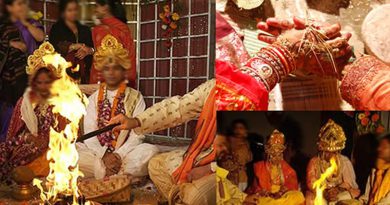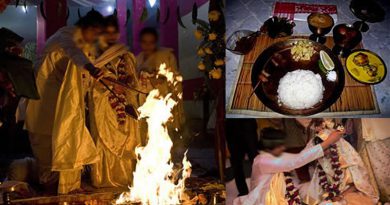Bengali Wedding and its traditional customs and rituals!
The marriage ceremonies in Bengal are quite long and elaborate. Bengali Marriage Rituals follow a long and elaborative list of rituals before and after the wedding.
GahoiMumbai.com is delighted to provide an insight to Bengali Wedding or the Bengali community Customs, traditions and rituals…
Bengali marriage ceremony takes place in the state of Bengal or among Bengali people. The marriage ceremonies in Bengal are quite long and elaborate. There are a number of rituals and ceremonies that take place during the marriage. The pre wedding and post wedding rituals provide sufficient opportunity to the loved ones to enjoy with each other. However, the traditional Bengali rituals are quite meaningful and exciting.
Bengalis are known to be creative, passionate and sensitive. They take pride in being the intellectual community of India. There creative minds reflect in their rich and warm marriages which also displays an intellectual dignity in the rituals. Bengali culture is known to blow conch at their religious and holy ceremonies and it also is a noticeable feature of their wedding functions. Another holy sound is Ooli, a sound made by the women with their tongues and by beating the palms on the mouth which is made throughout the ceremonies. This symbolically ensures that everybody`s attention is drawn to the main ceremony.
Bengali Marriage Rituals follow a long and elaborative list of rituals before and after the wedding. The Bengali weddings are usually accomplished with pre-engagement rituals, engagement, pre-wedding, wedding and finally post-wedding rituals. Every phase of wedding includes number of ceremonies that are accomplished by their purohits. Pre-wedding rituals usually include the traditional ashirbaad, aai budo bhaat, holud Kota and dodhi mongol.
Pre Wedding Rituals in Bengali Wedding:
Pre wedding rituals start with Vridhi Puja, which is done to remember the ancestors of the bride and the groom. This is followed by Dodhi Mangal ceremony, wherein ten married women bathe bride and groom. After this they are fed delectable traditional food. Hereafter, the couple is seated on wedding Piris and both the families exchange gifts. Next is the Gae Halud Tattva ritual, in which the bride is sent gifts by her in laws.
The next ritual is the Snan ritual, in which married women apply turmeric and oil to the couple. After bathing and wearing new clothes, the bride wears the Sankha Poranas. She is then ornamented with jewelry and crown along with sandalwood paste on the face. After this, is finally taken to the mandap, which is made using two banana trees and ornamented with fresh flowers and lights. A rice powder Rangoli is also made nearby.
The pre wedding rituals include Aashirwad ceremony, Vridhi Ritual, Ai Buddho Bhaat ritual, Wedding Piris, Dodhi Mangal Ritual, Haldi Uptan Ritual, Shakha Paula Ritual, Gae Halud Tattva , Adhibas Tattva, Kubi Patta, Snan, Mandap.
Aashirwad – a pre wedding Ritual:
The Aashirwad ceremony plainly translated as ’Blessings’, is performed a couple of days before the marriage. This is the sign of the beginning of the festivities. The bride to be is blessed by the elders of the boy’s family. The groom goes to the house of the bride. A sandalwood tilak is offered to the groom and offered gifts including a piece of gold jewellery along with some dhaan (rice husk signifying plenitude) and darba grass (symbolising that he will treat the bride with tenderness). As in all Hindu marriages, mishti (sweets) are then offered.
Vridhi – a pre wedding Ritual:
The ritual is about offering puja to the ancestors of the bride and the groom, performed a day before the wedding attended by all the family members. Alpana or rangoli is done and on it is placed a ghot with amra pallab. All the samagri or items for the puja are arranged in a baran dala with a `Sri` symbol made on it. A baran dala is a silver plate containing items for puja. The purohit brings an idol of Bhagwan Narayan to the puja. The idol is worshipped by lighting agarbattis (incense sticks) and diyas (lamps). The vridhi is usually performed by a paternal uncle. Tradition demands that the uncle and the bride/groom be on a liquid diet.
Ai Buddho Bhaat – a pre wedding Ritual:
The Ai Buddho Bhaat takes place in the bride`s home in the night before the marriage. This is a very grand very rich last supper (dinner) in her home.
Wedding Piris – a pre wedding Ritual:
The piris are brought to the bride`s house a day before the marriage or on the wedding day which are used to seat the bride and the groom during the marriage ceremony. A relative or friend paints and decorates the piris, conch shells are blown and ululation taken up. Tattvas or gifts are exchanged between the families of the bride and the groom prior during the pre-wedding and post-wedding ceremonies.
Dodhi Mangal – a pre wedding Ritual:
Early morning on the day of the marriage from the house of the bride/groom about ten married women accompany the bride/groom to a nearby pond. They invite the Goddess Ganga to the marriage and bring back a pitcher of water from the pond to separately bathe the bride and the groom. Then they offer food to the bride/groom. The meal consists of macher laija bhaja (fried fish) followed by jal dhala bhaja (rice cooked in water). Curd and chiruya complete the meal.
Haldi Uptan – a pre wedding Ritual:
In this haldi ritual, the bride is made to sit in the midst of four plantain trees (considered auspicious by the Bengalis) kept at four corners of the room. The paste of turmeric mixed with mustard oil is applied on her body. This is symbolic of making the bride`s skin glow and makes her more beautiful for the wedding ceremony. Totto ceremony which follows consists of gifts for the bride. A whole raw fish is sent for the bride along with other sweets, turmeric, saris and pumpkins.
Shakha Paula – a pre wedding Ritual:
While Vedic mantras are said by the purohit (priest), seven married women adorn the bride`s hands with the traditional bangles made of shankha (shell) and paula (coral). The shell is supposed to mirror the qualities of the moon, thereby implying that the girl remains serene and calm. The coral is supposed to be advantageous for health.
Gae Halud Tattva – a pre wedding Ritual:
A relative of the groom arrives at the bride`s house with Gae halud tattva (gifts) for the bride. The gifts include at least six sarees and cosmetics to go with them. Also among the gifts are fish, assorted sweets, curd, paan, dhaan and durba. Incense is lit to welcome them and conch shells are blown. The bringers are given sweets and bakshish.
Adhibas Tattva – a pre wedding Ritual:
Adhibas Tattva are gifts coming from the bride`s house. The gifts come on a brass plate or kasar thala borne by servants includes a saree for the groom`s mother, and fish, sweets, curd, paan, dhaan, and durba. They are welcomed as warmly as the groom`s gift bearers who visit the bride`s house.
Kubi Patta – a pre wedding Ritual:
A ceremony to worship Saint Kuber takes place in the houses of the bride and the groom. On the day of the wedding, family members place three metal glasses filled to the brim with dhaan, khoi (pulses), and crushed rice at the altar of the Saint.
Snan – a pre wedding Ritual:
The snan takes place in the late afternoon or evening, the bride and groom must separately follow on the day of the marriage. A few married women apply turmeric and oil on the hair and body of the bride/groom. After bathing, the bride and groom must wear the new set of clothes that have been presented to them by their in-laws. The worn clothes are later given away to a napti (barber).
Dressing Up The Bride – a pre wedding Ritual:
The bride adorns herself in all her bridal attire. Her hair is tied into a bun and covered with a veil. The mukut is placed on her head and secured in place by pinning it to the veil. After her bridal makeover, a design of the mukut is traced on her face using the chandan paste. The bride must sit with the gaach kouto and kaajal laata for the ceremonies that follow.
Mandap – a pre wedding Ritual:
The mandap is the place where the wedding ceremony is occurred, two banana trees are planted at the mandap and a large alpana is made with rice paste. The mandap is decorated for the event with flowers and lights.
Wedding Rituals in Bengali Wedding:
The wedding day begins at 4.00 am for the bride. She bathes and dresses in a white sari with a red border (white symbolizing purity and chastity, and red, fertility). She wears all her jewellery and is fed a mixture of puffed rice, curd and sweets before dawn. Sweets, water or sharbat is all she can have. The men folk of the girl`s family – her father, uncles and brothers, perform a vridhi ceremony mid-morning, through which they offer water to the souls of their ancestors to invoke their blessings.
The marriage day rituals begin with welcoming the groom. An elderly female relative welcomes the groom with baran dala. It is a plate which is first touched to the forehead of the groom, then touched to the ground and then again touched to his forehead. After this, the groom is given sweets and sherbet. As he enters the house, rose water is sprinkled over him. The next is the Shubho Drishti ritual, wherein the bride and the groom see each other from under a sheet for the first time.
This is followed by Mala Badal ceremony, wherein they exchange garlands. The most important rituals on the marriage day are Saat Paak, during which the bride is seated on a wooden plank and lifted by her brothers. Afterward she is taken around the groom seven times, which signifies their union. In Sampradhan ritual the paternal and maternal uncles of the bride, give her away to the groom. After this, the Saptadi ritual takes place.
Welcoming the Groom in Bengali Wedding:
The groom and his relatives arrive at the bride`s house to the ringing of bells, blowing of conch shells and ululation. The baran dala is held by an elder female relative of the bride`s and the plate is first touched to the groom`s forehead, then to ground, and back again to his forehead in a gesture of part blessing, part-reverence. The groom is offered sweets and sherbet. Water is sprinkled on the doorstep as the groom steps into the house to mark the auspicious moment. Both, the mother of the bride and of the groom do not attend this ceremony. It is believed that this will protect the couple from the `evil eye`.
The Bengali Wedding Day Ceremony:
The purohit conducts the wedding ceremony. The bride and groom exchange garlands while the purohit chants mantras. Her paternal or maternal uncle gives the bride away. This particular part of the ritual is called sampradhan.
The couple is first ceremonially seated on special piris (stools) in front of the Agni (sacred fire) in the Yagya ceremony. This is followed by the Saat Pheras. The traditional grinding stone, on which masalas are ground, is placed upside down. Near this, seven circular alpanas (rangolis) are drawn, and one paan is placed on each one of them. The bride stands in front and as she takes her first step on the stone, the groom gently nudges her left foot with his right. She then places her foot on the first alpana. These seven rounds are known as Saat Pheras, signifying the sanctity and solemnity of wedding.
Most of the Hindu weddings involve fire offerings; Bengali`s name the ceremony as Anjali. The groom takes the bride`s palms in his and the girl`s brother fills them with Khoi (popped rice) that is offered to the holy fire.
A traditional Bengali wedding is completed with the Sindoor Daan. The bride covers her head with a new sari offered by the groom. He dips a ring into sindoor and traces a line of it from between the girl`s eyebrows through the parting in her hair. Now the couple is considered authoritatively married. This is followed by a lavish wedding feast where a number of varieties of fish are served along with a variety of other non-vegetarian dishes and sweets.
Post Wedding Rituals in Bengali Wedding:
After the wedding the Basar Ghar ceremony takes place, wherein the newlywed couple is treated affectionately and served delicious food. On the next morning the Bashi Biye ritual takes place in which the groom applies vermilion on the bride’s forehead. After this, the Bidaai ritual is held and the bride leaves with the groom for her marital home. The first ceremony at groom’s place is Bou Baran, which is a welcome ceremony for the bride. The bride submerges her feet in a plate containing lac dye and milk and enters the house, leaving footprints. The next is the Bou Bhat ceremony. It is held as the bride eats her first meal in her husband’s house.
Reception – A Post Wedding Ceremony:
The bride`s family holds a reception and a grand feast. The newlyweds spend the first night in the bride`s house, playing traditional games with cowrie (shells) with their friends throughout the night. There is a lot of fun with song and dance.
Bidaai – A Post Wedding Ritual:
This refers to the bride`s farewell from her maternal residence. As she steps out, she throws a handful of rice over her head into her mother`s aanchal. This gesture signifies that she has repaid all her debts to her mother and she wishes all the prosperity to her maternal home as she goes to flourish her man`s life.
Basar Ghar – A Post Wedding Ritual:
The bride enters the house, first stepping on an ornate stool, which will be hers for life, and then she dips her feet in alta (red colour) and milk. She is then presented with the traditional red and white ivory bangles, which symbols of a married woman, along with a metal bangle are called, loha, which she must wear for the rest of her life.
Bou Baran – A Post Wedding Ritual:
This ritual is performed to welcome the bride and groom to the groom`s home. The women of the house pour water on the ground beneath their vehicle when they alight. The groom`s elder brother`s wife holds a plate containing lac dye and milk under the bride`s feet. Having imprinted the soles of her feet thus, she leads her by the arm into the house. The elders of the house bless the newlyweds.
Bharan Poshan And Bahubhaat – Post Wedding Rituals:
At the groom`s house, there is a welcome meal for the couple. The groom gives his bride a plate laden with sweets and a sari, to signify that he will hereafter provide her with whatever she needs, Bharan Poshan. The bride then prepares a rice dish, Bahu Bhaat to serve the whole family, symbolising that she has finally been accepted into the fold.
Kaal Ratri – A Post Wedding Ritual:
In the evening, the groom`s family holds a reception. The second night after the wedding, the groom and bride are not allowed to even look at each other.
Dira Gaman – A Post Wedding Ritual:
A ceremony that is conducted when the newly-weds visit the bride`s house for the first time after the marriage. The thread that was tied by the purohit on the bride`s wrist during the wedding rituals is cut during this ritual. Conch shells are blown to the accompaniment of ululation to mark the auspicious moment.
Phool Shojja and Suhaag Raat – Post Wedding Rituals:
On the third night after the marriage, the bride and groom are adorned with flowers. Their bedroom is also decorated with flowers. This Phool Shojja and Suhaag Raat form the end of the wedding ceremonies.
Bashi Biye – A Post Wedding Ritual:
The next morning, the groom adorns the forehead of his bride with vermillion. He does this by looking into a mirror. The newly-weds visit the mandap, and worship the Sun God in the presence of the purohit.
If you need any help regarding Bengali wedding ceremony or Bengali Wedding Management, please leave your message about your dates, ideas and budget plans at our Wedding Help Centre.
All this information is free and only for informational purpose.




